Tips for regular items to add to your lessons
Building a routine into your lesson planning creates a feeling of familiarity for kids, which helps them to gain the confidence they need in class. It also allows the teacher to build on previous lessons by recycling old vocabulary before introducing new language.
Here are 10 key elements that can be included in your lesson plans on a regular basis for the younger students that you teach.

1. Name tags (warm-up section)
Using name tags can be a life saver if you have lots of kids classes – learning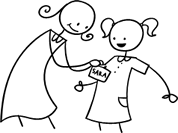 everyone’s name at the beginning of the school year can be a nightmare! Younger kids also love to wear their name tags – they do so with pride. Sticky tags are good – write their names and stick on their shirts.
everyone’s name at the beginning of the school year can be a nightmare! Younger kids also love to wear their name tags – they do so with pride. Sticky tags are good – write their names and stick on their shirts.
- Pre-writing age: when your students are too young to write their name, start each lesson by sitting in a circle around the name tags with the names of your students written on. Point to each one and ask whose it is. Students will start to recognize their names pretty quickly, after a couple of lessons they’ll be picking out their tags straight away. When they pick out their tag they can stick or pin it to their shirts.
- Writing age: once your students are able to recognize their names you can move onto writing. Start by making dot-to-dot name tags for each student, so they can trace their name. At some point your students will be able to progress onto copying their names and finally writing their names without needing to see them.
2. Puppet greetings (warm-up and wrap-up section)
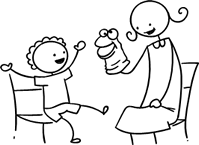 Use a glove puppet (such as a Sesame Street puppet) to greet each student. Keep him in a cloth bag. Bring out the bag, open it enough to see in and shout into the bag the puppet’s name (e.g. “Cookie Monster!”). Then move your ear to the opening to listen – nothing. Go to each student and encourage them to shout the
Use a glove puppet (such as a Sesame Street puppet) to greet each student. Keep him in a cloth bag. Bring out the bag, open it enough to see in and shout into the bag the puppet’s name (e.g. “Cookie Monster!”). Then move your ear to the opening to listen – nothing. Go to each student and encourage them to shout the
puppet’s name into the bag – each time nothing happens. Finally, get all the students together to shout the name at the same time. This time the puppet wakes up and jumps out of the bag! The puppet then chats to each student: “Hello”, “What’s your name?” “Goodbye / See you” before going back into the bag and back to sleep.
Do this at the beginning and end of each class. Over time you can add more questions to the conversation, such as:
- How are you?
- How old are you?
- Where do you live?
- Do you like (apples / milk / cheese / etc.)?
- What (food / colors / animals / etc.) do you like?
- What is your favorite (food / color / animal / etc.)?
- Can you (jump / sing / fly / etc.)?
3. Hello / Goodbye song (warm-up and wrap-up section)
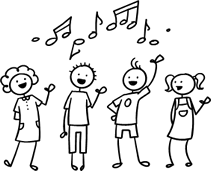 Start and end each lesson with a familiar song – this helps to signal to your students that it is time to start the lesson (and get serious!) and time to go home at the end. Our Hello and Goodbye songs are perfect for this.
Start and end each lesson with a familiar song – this helps to signal to your students that it is time to start the lesson (and get serious!) and time to go home at the end. Our Hello and Goodbye songs are perfect for this.
Sit in a circle and sing along to the song. Encourage students to clap along or pat their laps in time with the music.
4. Homework check / Assign homework (warm-up and wrap-up section)
In the beginning section of the lesson, you can check your student’s homework. Ask each student some questions about their homework worksheet (e.g. “What color is it?”), give lots of praise, and then put a mark on the homework sheet (e.g. a sticker, a stamp or draw a smiley face). Finally, tell your students to put their homework back into their bags.
At the end of the lesson you will need to set homework – a worksheet is the best option. Hold up the homework worksheet and model how to do it. Give out the worksheets and say “Put your homework in your bags” and help them to do so.
5. Exercise routine (warm-up section and any other time)
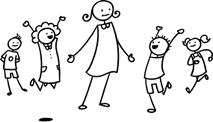 This is a fun activity to do each lesson – it gets everyone up and moving around and is a good signal for the start of the main part of the lesson.
This is a fun activity to do each lesson – it gets everyone up and moving around and is a good signal for the start of the main part of the lesson.
Say the following and have your students follow your lead: “Stand up (teacher stands and so does everyone else), “Hands up / hands down” (x 3-5), “Jump” (x 3-5), “Run! / Stop!” (x 3-5), “Turn around! / Stop!” (x 3-5), finally “Sit down”. Throughout the course you can introduce other commands, such as “Hop”, “Star Jump”, “Wiggle”, “Crouch” and so on.
This is a great tool to use at any time during the lesson to kick everyone into a higher gear, or if you need everyone to burn off some energy.
6. What’s in the bag? (warm-up section)
 This is a great activity to do at the beginning of your lessons. Fill a large cloth bag with items from your previous lessons (e.g. plastic fruit, animals, etc.) as well as any other random objects (e.g. an eraser, a plastic bottle, a plastic cup – anything lying around and safe!).
This is a great activity to do at the beginning of your lessons. Fill a large cloth bag with items from your previous lessons (e.g. plastic fruit, animals, etc.) as well as any other random objects (e.g. an eraser, a plastic bottle, a plastic cup – anything lying around and safe!).
Show the bag to your students and shake it to rattle the objects inside. Pull out different objects, teach/elicit their names, have students hold and pass the objects around. You can even have students pull objects out of the bag. Pull out 1 or 2 objects per student. Finally, place the objects around the classroom and have each student retrieve each object as you call out its name and put it back in the bag.
During the year, slowly add more and more items to the bag – by the end of the year you’ll have a bag full of items and your students will know the names or them all!
7. Review time (warm-up section)
Always include a review section to your lesson. You can review the previous lesson and also language from any lessons from the past. The key is to make this section fast and fun!
Here are some things to review:
- do a couple of games and activities from a previous lesson, especially ones that went down well!
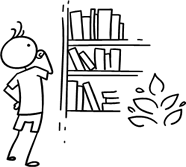 Review a story – you can read a classroom reader from a previous lesson. If you display all of the readers you have read, students can choose what to review.
Review a story – you can read a classroom reader from a previous lesson. If you display all of the readers you have read, students can choose what to review.- review a song from a previous lesson – again, you can do a different review song each week. A great way to involve your students is to have your students choose which song to do. Each time I learn a new song with a class, I put the song poster on the wall (each of our songs have accompanying posters). Students use these to choose which song to review.
8. Play time (half way through the lesson)
Having a short 5-minute play time break is a really nice way to get to know your students through play – this is especially effective with 5s and under. Each class, announce that it is “play time” and everyone can choose something in the classroom to play with … toys, crayons and paper, balls, blocks, etc. Obviously, this requires a well-stocked classroom! Then join in and play with each student – they love this! As you play, talk to your students and ask questions, and have fun!
9. Clean up (wrap-up section)
Always have your students to clean up: tidy away toys and stationery, put their cushions away, clean the board, put their things in their bags and put on their coats. At first, you will need to show everyone what to do, but in no time at all they will be able to do this at the drop of a hat.
10. Line up – quick check and goodbye (wrap-up section)
When it is time to leave the class make sure everything is put away and the students have gathered up their belongings. Have them line up at the door and place yourself between the door and the students. For each student, check one new word (e.g. hold up a color or fruit and ask, “What’s this?”). When they answer correctly, say goodbye and let them leave. If they get the question wrong, they go to the back of the line to try again.



